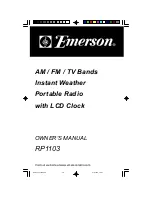
EN
2
Tuning Knobs
The right hand concentric knobs are used to tune the radio. The large knob
adjusts the MHz portion of the standby frequency, and the smaller knob
adjusts the kHz portion of the standby frequency.
Pressing the end of the small knob changes the channel spacing that the small
knob operates through. If the radio is configured for 8.33 kHz operation, the
steps toggle between 8.33 kHz channels and 25 kHz channels. If the radio is
configured only for 25 kHz operation, the steps toggle between 25 kHz and 50
kHz channels.
Changing the step size does not change the behaviour of the radio, only the
tuning knob step size
–
it helps to quickly tune a frequency.
The TY96A and TY97A do not support 8.33 kHz operation and so the steps will
only toggle between 25 kHz and 50 kHz; again, changing the step size does
not change the behaviour of the radio and only changes the step size between
25 kHz and 50 kHz.
Flip-flop Button
The flip-flop button swaps the frequency in the standby position into the
active position, and moves the active frequency to the standby position.
MON Button
The VHF radio includes a dual-frequency listen feature; pressing the MON
button toggles this feature on and off.
When the monitor is active, a
+2
icon appears next to the standby frequency,
and the radio will scan between the active and standby frequencies listening
for transmissions. The primary channel has priority
–
a transmission on the
primary channel will interrupt the secondary channel. As an aid to identifying
which channel is active, the
RX
icon will light next to the active channel and
the secondary channel will appear slightly quieter than the primary. If your
radio is wired for stereo and you are using a stereo headset, the secondary
channel will also appear to be to the right of the primary channel.
This is useful in an aircraft with only a single radio since it allows you, for
example, to copy the ATIS whilst maintaining a listening watch on the ATC
frequency.





































